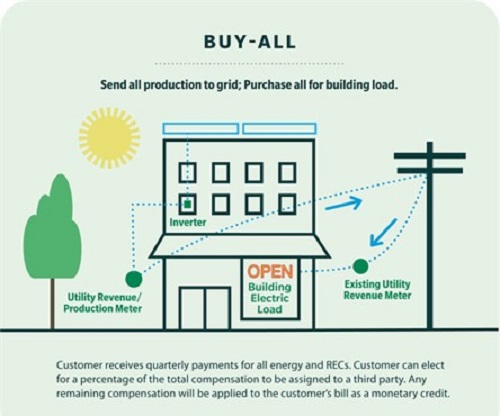The Non-Residential Renewable Energy Solutions (NRES) program offers generous solar incentives for Connecticut businesses and property owners to transition to low cost, renewable energy – a proven way to save money on your electric bills, stabilize your electricity rates, or add a new source of revenue.
However, time is running out to get into the next round of incentives.
How to “Monetize” Solar Incentives on Your Solar Project…
You can choose to own the array, or allow Solect to own the array. Either way, you benefit from the Connecticut NRES Program incentives.
1. Owning the Solar Installation
If owning the solar installation is right for you, you can pick from two compensation options through the NRES Program: Buy-All or Netting.
Buy-All: Send all the electricity from your solar project to the electric grid, without supplying power to any on-site energy consumption.
- The utility purchases the power from you at a fixed 20-year rate which is approved by the Public Utilities Regulatory Authority (PURA).
- A Renewable Energy Certificate (REC) is generated for each megawatt-hour (MWh) of electricity that your system generates.
- You receive compensation as either an on-bill credit to offset your monthly bill, or a quarterly or annual cash payment to a third party. (You can specify a percentage of your compensation to be split between the two options).
- Any on-bill credits not used to offset your bill can be cashed out at the end of the 20-year term.

- Netting: Use the electricity generated from your solar project to offset your site’s energy consumption; monthly excess generation is carried forward as a credit on your bill which can offset future energy costs.
- Every kilowatt-hour (kWh) produced by solar offsets a kWh of supply and delivery charges on your electric bill.
- Separately under the NRES Netting incentive, projects receive a quarterly payment for RECs from the utility at a rate set for 20 years, which is separate from the savings on the electric bill.
- Monthly excess generation from your system is sent to the grid and receives net metering credits, which are applied to your bill in dollars at the full kWh retail value, and used to offset future electric supply and delivery charges.
- Net metering credits are carried forward each month, and cashed out if you stop electric service.

2. Let Solect Own the Solar Installation
- Lease – Lease your roof to Solect, and receive a lease payment for the term of the lease, typically 20 to 25 years. Lease payments can be in regular installments, such as annually, or a combination of an upfront payment and regular installments. An upfront payment is a way to pay for roof upgrades before solar is installed, or other property enhancements.
- Power Purchase Agreement (PPA) – A PPA is a financing model in which a third party investor (like Solect Energy) builds, owns, and maintains the solar system on your property, enabling you to purchase the energy at a discounted rate for 20+ years without having to come up with the money to buy the installation.
If not owning the solar installation is your preferred approach, you can decide between a lease agreement or a Power Purchase Agreement (PPA).
Who Is at Risk of Missing Out
Currently, projects that are < 200kW can apply anytime their application is ready since their incentive agreements are awarded on a first come, first served basis. Proposed changes by the utilities may impact this. As a sizing reference, an approximately 20,000 square foot roof is needed for a 200kW solar installation.
A deadline is looming for projects that are > 200 kW and < 2,000 kW. These larger projects are awarded incentive agreements through a competitive bid process during two annual bid periods. In 2023, the first application period opens in February, and lasts for six weeks. The second application period is in August.
| Category | Project Size (AC) | Project Selection Process |
|---|---|---|
|
Small Zero Emissions Projects |
< 200 kW |
Ongoing, first-come, first-served |
|
Medium Zero Emissions Projects |
> 200 kW and < 600 kW |
Competitive Solicitation |
|
Large Zero Emissions Projects |
> 600 kW and < 2,000 kW |
Competitive Solicitation |
Exciting Changes in Federal Incentives
Recent developments in federal incentives make the economics of going solar even better! With the signing of the Inflation Reduction Act (IRA) of 2022, the investment tax credit (ITC) increased to 30%. Plus, the potential to stack bonus credits onto that base rate means certain projects could be eligible for a total federal tax credit of 40%, 50%, or more! Learn more about the changes to the federal incentives by reading Quick look at how the new federal solar incentives can help your business.
Go Solar!
NRES presents a compelling financial opportunity for Connecticut businesses and property owners to go solar, especially when combined with the generous federal incentives.
If you would like to discuss how your organization might leverage these incentives to save money on your electric bills, stabilize your electricity rates, or add a new source of revenue, schedule a free, no obligation consultation with Solect Energy. You can contact us by email info@solect.com, phone 855.800.4211 (press 1), or click on the button below to schedule an initial consultation.
October 3, 2022

